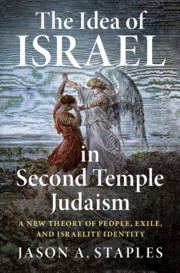Book contents
- The Idea of Israel in Second Temple Judaism
- The Idea of Israel in Second Temple Judaism
- Copyright page
- Dedication
- Contents
- Tables
- Preface
- Abbreviations
- Introduction
- Part I Israel’s Disputed Birthright
- Part II Restoration Eschatology and the Construction of Biblical Israel
- Part III Israel and Restoration Eschatology in the Diaspora
- 6 Exile and Diaspora Theology
- 7 Israel, Jews, and Restoration Eschatology in Josephus
- 8 Israel and Restoration in Philo of Alexandria
- 9 Exile and Israel’s Restoration in the Dead Sea Scrolls
- 10 Israel, Jews, and Restoration in Other Second Temple Narrative Literature
- 11 Israel in Second Temple Eschatological and Apocalyptic Literature
- 12 Israel, Hebrews, Jews, and Restoration Eschatology
- Bibliography
- Index of Primary Sources
- General Index
10 - Israel, Jews, and Restoration in Other Second Temple Narrative Literature
from Part III - Israel and Restoration Eschatology in the Diaspora
Published online by Cambridge University Press: 29 April 2021
- The Idea of Israel in Second Temple Judaism
- The Idea of Israel in Second Temple Judaism
- Copyright page
- Dedication
- Contents
- Tables
- Preface
- Abbreviations
- Introduction
- Part I Israel’s Disputed Birthright
- Part II Restoration Eschatology and the Construction of Biblical Israel
- Part III Israel and Restoration Eschatology in the Diaspora
- 6 Exile and Diaspora Theology
- 7 Israel, Jews, and Restoration Eschatology in Josephus
- 8 Israel and Restoration in Philo of Alexandria
- 9 Exile and Israel’s Restoration in the Dead Sea Scrolls
- 10 Israel, Jews, and Restoration in Other Second Temple Narrative Literature
- 11 Israel in Second Temple Eschatological and Apocalyptic Literature
- 12 Israel, Hebrews, Jews, and Restoration Eschatology
- Bibliography
- Index of Primary Sources
- General Index
Summary
This chapter looks at a variety of early Jewish narrative texts, showing that "Israel" language is preferred in texts from the pre-exilic past or when explicitly referring to northern Israelites, while "Jew" (Ioudaios) language is avoided in these texts. The converse is true in texts set in the post-exilic past not explicitly dealing with northerners, where Ioudaios appears frequently and Israel language tends to be limited to prayer or cultic contexts. The chapter pays special attention to the book of Tobit, which tells the story of God's continued faithfulness in preserving the lineage of a faithful family from Naphtali, the first tribe to be taken into exile by Assyria. Tobit's concern for the continued existence of faithful Israelites to be included in the final restoration provides a critical witness for the continuation of pan-Israelite sentiments—and the continued distinction between Israel and Judah—well into the Second Temple period. Other books such as Judith, Jubilees, and the Letter of Aristeas further witness to the persistence of the distinction between Israel and Judah and pan-Israelite restoration eschatology.
Keywords
- Type
- Chapter
- Information
- The Idea of Israel in Second Temple JudaismA New Theory of People, Exile, and Israelite Identity, pp. 290 - 315Publisher: Cambridge University PressPrint publication year: 2021



